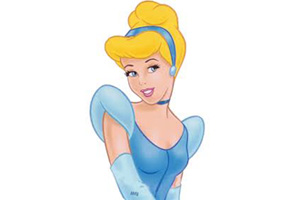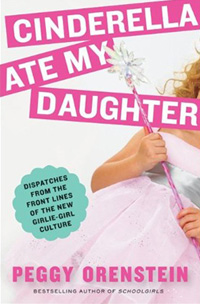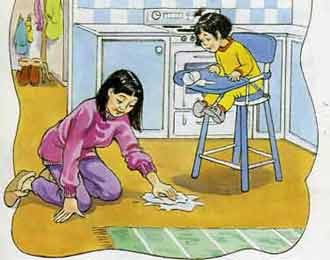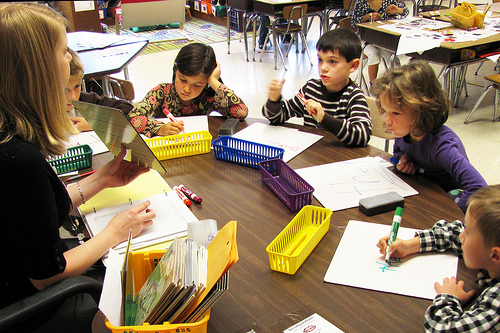
Where do Disney princesses fall on a 1-to-10 scale of harm to a girl’s identity? How about Bratz, pink mania, Facebook? “All of this stuff seems 1, but might be 10, and you don’t really know,” says author and New York Times Magazine essayist Peggy Orenstein as we chat about her new book. “It’s not any one thing. It’s the whole onslaught.” Cinderella Ate My Daughter is a highly entertaining (and disconcerting) romp. Orenstein hangs out with teachers, teenyboppers, marketing execs, social scientists, tots in tiaras, and her own seven-year-old to probe the beguiling contradictions of our growing girly-girl culture. Referring to the nearly half of six- to nine-year-old girls who wear lipstick or gloss, Orenstein tells me, “I don’t know why the percentage is not zero.” Read on for her lowdown on gender-branded diapers, Facebook’s dark side, and how the parents of preschool beauty queens are more like us than we’d care to admit.
Mother Jones: You wrote that you had originally wanted a boy because you were afraid you might not be able to handle a daughter. Is having a daughter really that much more precarious than it was, say, 20 years ago?
Peggy Orenstein: I think part of it was that I had been the supposed expert for the last 20 years, so I had 20 years of anxiety. [Laughs.] But yeah, I think it’s a funny time, because on one hand there’s all this good news about girls in education, girls in sports, they’re doing great in college and all that, but at the same time the pressure hasn’t abated at all on them. And I would (and do) argue that’s the pressure has grown much more intense to define themselves and gain all their self-worth from the way that they look, and the way that they look is supposed to be, increasingly and increasingly younger, sexy. And femininity becomes defined for them by sexiness (you know, at the age of four), narcissism, and consumerism—all three of which are problematic for me.
MJ: Now let’s see, 20 years ago there was—
PO: There’s a couple differences. One is the market has gotten increasingly segmented. The girl stuff has gotten more girly; the boy stuff has gotten more boy-y. Two is that you have internet culture, which is 24/7, 365 days a year. And as they get older you have, not with littlest girls, but you have social media and all of that, and this very deep concern generated from that with how you present yourself. And your image becomes your self-image and your brand—there’s a study where kids use that word to talk about their online persona.
 MJ: So basically, kids have to be little marketers themselves.
MJ: So basically, kids have to be little marketers themselves.
PO: Yeah, marketing themselves. Or becoming their own little mini-Mileys or whatever the latest one is—their own little icons.
MJ: I found interesting your observation about how marketers of girly-girly culture rationalize their stuff as empowering, when it fact it’s kind of limiting.
PO: Well, yes. It can feel like it’s empowering because you think, well, girls are freer to express their femininity and their sexuality and we’re not tamping that down or denying it anymore. But it ends up putting them, first of all, in this box. And secondly, premature sexualization of girls actually does the opposite of what people think it might; it actually disconnects them from their sexuality and makes for decreased sexual health as they get older. My kind of nightmare quote is from Deborah Tolman, who does research on girls and desire and is, I think, brilliant. She told me that by the time girls are teenagers, when she asks them how sexual experience made them feel, they respond by how they think they looked; they think that how they look is how they feel.
MJ: Yeah, that bit kind of blew me away.
PO: I just found that very striking, and very much of this era. I think there’s a lot of effort into making us think it’s benign, or that we can’t do anything about it. But the mythology that this represents more freedom for girls, and more power and greater sexual health and greater self-efficacy, all of that; I think the evidence is really very much to the contrary. And nowhere do you see it really like writ large more than in these other Disney princesses. You know, Miley and Lindsey and Britney and now Demi Lovato, I don’t know if you’ve heard of her.
MJ: No. [She’s a teenage pop singer who portrays a teenager in the Disney Channel comedy series Sonny With a Chance.]
PO: She just went into a rehab for eating disorders and cutting and other sorts of things. It’s an embarrassment for Disney. I mean, I don’t know why they don’t think they have to respond to what they’re creating, but apparently they don’t. They put the blame on the girls, or on families, or on stuff like that, not on the ideas that they’re trying to make those girls embody—literally.
MJ: So beyond just the girl stuff, a lot of today’s toys feel so prescribed to me. Like the building toys come in these specific kits, and the dolls come with these defined stories—
PO: I know!
MJ: Are we sending this message that kids needn’t use their imaginations?
PO: My biggest surprise as a parent, or one of them, was how much of my job is about protecting my child’s childhood. And when I think about what that means, in addition to her not wearing makeup when she’s three years old, it’s about imagination and making sure that her imagination isn’t colonized by these prescribed scripts. I’m personally concerned with the script for girls. And for boys, too, but that’s not what I write about. I don’t mind that Daisy plays a little bit of princess now and again, or did when she was littler; that’s fine. But if she’s walking around doing the Cinderella story, and not even the Cinderella story, but the version which is all about getting the most stuff, then that’s a problem. And there is evidence on violence, kids are acting out a prescribed script over and over and over—homogeneously across the country in their play—after they’ve been exposed to these TV shows or Internet stuff or robotic toys or whatever. I find that disheartening, and I’m sure it must contribute to this drop in creativity scores we’re seeing.
MJ: Are we?
PO: Yeah, if you look at that Po Bronson story on the creativity crisis in Newsweek, there’s been a steady drop in what they call “creative intelligence” scores since 1990, with the biggest drop being among elementary school students.
MJ: Okay, so let me have you rate the following on a 1-10 scale, with 10 being the most insidious for girls’ development (1 is Mother Theresa, 10 is Dick Cheney): Disney Princesses.
PO: I’ll tell you what is insidious about the Disney Princess, besides the fact that if you look into their merchandise, the 26,000 items, you’re always finding books that are about “my perfect wedding.” It’s what it puts girls on the path for. And that it poses as something that protects girls, or staves off premature sexualization, when I think it primes them for it. I don’t know where to put that on the continuum exactly. I guess eight?
MJ: American Girl?
PO: Five.
MJ: Barbie. The modern Barbie.
PO: One and Ten. [Laughs.] I’m so ambivalent about Barbie. I love and hate Barbie. I can’t help it.
MJ: Bratz?
PO: Ten. [Laughs.] Monster High. You’re forgetting about Monster High!
MJ: Okay, Monster High?
PO: Ten!
MJ: Social media?
PO: Again, one and ten. Just depends, and it depends on the age.
MJ: One of the things that struck me as a new parent is how innate some of the stereotypical gender roles tend to be. So that’s okay. But then the marketers have learned how to exploit these roles so young…
PO: To amplify them and emphasize them and create them when they don’t exist and amplify them when they do exist, yes.
MJ: So, is the female attraction to pink entirely nurture?
PO: It appears to be, since it didn’t exist 100 years ago. It’s totally socially constructed. And I think that one of the things that marketers do is convince us that something is natural when it’s really been naturalized, and that’s the whole point of marketing gender; it’s “natural.” Well, yes and no. It’s natural for little girls to want to assert that they’re little girls with whatever the culture gives them, because they want to make sure they stay little girls, because the whole penis-vagina thing hasn’t quite kicked in and they don’t know if their anatomy might switch and they might grow up to be something else. That’s kind of scary, so they want to make sure that everyone knows you’re a boy and everyone knows you’re a girl. So you fixate on extremes that represent your gender, and that’s a natural thing to do.
But when it is then packaged and sold to you in this extreme way, it separates the cultures of boys and girls, making it harder and harder for them to see one another as people—as the other sex rather than the opposite sex. It makes it very hard for them to be friends and to learn from one another. The research in the book that really struck me was the value of cross-sex play for both boys and girls, when it happens naturally. And you wonder, when everything is so coded, how do you do that? How do you play with the boy next door if you’ve got the pink Magic 8 Ball and the boutique Monopoly? And conversely, I think girls begin to think if something is not pink, it’s not for them, and that’s problematic. I mean, there’s only one pink Lego kit. If pink is your only color, that’s the only one you can get; everything else is for boys.
MJ: I was appalled as a parent that you can hardly find a diaper that isn’t gender branded. They all have Disney Princesses on them, or Cars characters.
PO: I know. It’s very annoying.
MJ: I would walk into Safeway and say, “WTF?” Isn’t there something generic?
PO: It’s true. At a certain point the children are cognizant and then they realize. But I always am concerned when people go the opposite way with girls; like when they say, “I never let my daughter play with dolls,” or “I bought her the Cars diapers,” or whatever. She knows those are boy things, so you’re telling her that that which is associated with girls is somehow inferior, and I don’t consider that an antidote. I think one of the challenges is to create an equally positive, joyful, fun, satisfying sense of femininity and feminine identity in a different way so that there are things you’re saying yes to and satisfying that urge that your daughter has to be assert her girlness. The surface level of the culture, and really several inches into it, makes that very hard to do. I hate to put another thing on parents’ plates, and especially on mothers’ plates (because often it falls to them). But the culture is very intentional in what it’s telling your daughter and what it’s telling you about the message of femininity. And if you’re not intentional and conscious back, you lose.
MJ: Daisy knows you write about her, right?
PO: Yeah. She knows. She hates the title of this book, by the way. Hates. Hates. Hates.
MJ: Does she feel like she’s in the spotlight?
PO: I don’t know. I think she will, and I don’t think I’m going to do it for too much longer because of that. I think she’s kind of young enough that it doesn’t matter much. Another couple years, you know, I’ve got to stop. She feels special for it: She told one of her friends that she’s famous—that her name is in the title of a book.
MJ: Well, she is sort of famous.
PO: Well, every once in a blue moon, somebody recognizes the two of us together. You know, maybe three times, but it’s happened. If I yell like, “Daisy, stop that!” across Andronico’s [a local grocery store]. People will turn and see the two of us and they’ll say, “You must be Peggy.” But that doesn’t happen very often. Much more often, I go into a bookstore and they take my credit card and have no idea who I am, and I feel depressed!
MJ: So, once kids enter school, the peer influence and pervasiveness of the gender marketing becomes even stronger. Is it a losing battle for parents?
PO: I think we’re made to think it’s a losing battle. A really good analogy is the food movement: Not that long ago, the idea of feeding your kid with organic fruit and vegetables or paying attention to sustainability or any of that—that was very fringy. And I guess some people will argue it still is to a degree, but it’s kind of mainstream fringy now.
MJ: If you can afford it.
PO: Yeah. But people all over are attentive to this, and it matters, and people are bringing it to the schools. Even McDonald’s has had to put in some kinds of healthy choices. If you can get McDonald’s to move a little bit, we’ve got to be able to do the same for Mattel.
MJ: But Mattel’s just going to follow its bottom line.
PO: So is McDonald’s. Right. So if people stop [buying], or people demand some alternative, they’ll make it. And the question is, will people do that?
MJ: It demands that parents say no to all the stuff that companies are putting out there that the kids salivate over, so you have to be this naysayer…
PO: Well, when kids are little, you can just say no. You really can. But you do find yourself saying no all the time, which is the dilemma. That’s why you have to do the work to find the things that you can say yes to. And sometimes that is work. But it’s fun work and rewarding work. And you get to read children’s books, and that’s always better than reading grown-up books.
MJ: Definitely!
PO: There’s real value to thinking more consciously about toys. And as parents are more like-minded about it, that gives you some support as well. There was this really interesting nugget that I saw in an article in the New York Times about elementary school-age girls and bullying. And they had these two points that really resonated with me: One was that girls who watch Hannah Montana are bullying more than other girls, are more relationally aggressive than other girls. But it has no effect on boys. I thought that was kind of interesting.
MJ: Hannah Montana, 1-to-10?
PO: I think the point is that all of this stuff seems one and might be ten, and you don’t really know. And it’s sort of not any one thing. I think it’s the whole onslaught—the combination that’s coming at girls. When you look at it one by one, with the exception of some of the really out-there things like Bratz, it is hard to tell. And it is intentionally confusing to parents. Hannah Montana—yeaah, it’s just stupid. But on a scale of one to ten, how bad is it that Miley Cyrus was wearing a promise ring when she was 16? I think that’s a 10. I don’t want this girl wearing a promise ring and then turning around and, you know, objectifying herself a year later. That’s not a good message. And the script of the show apparently it is a problem because apparently it makes girls aggressive.
MJ: Where do you stand on single-sex classrooms?
PO: Depends on the class. Depends on the school. Depends on the girl. I think regressive discussion about single-sex classrooms, like the Leonard Sachs stuff, is just patently absurd—that, like, boys learn better standing up, moving around, when the walls are painted blue, and when it’s cold in the room. And girls learn better in a circle and when it’s warm and sharing. I mean, it’s all the most stereotypical drivel and it goes back to that issue of reinforcing separate cultures of gender—and that is a 10! That is a harmful thing—the idea that you reinforce, amplify and ensure the separate cultures, and deny the opportunity for cross-cultural communication and play and discussion and learning. That’s just a gigantic problem.
MJ: In one chapter, you hang out with the parents we all love to hate: Those who enter their five-year-old daughters in beauty pageants. Your treatment was quite sympathetic.
PO: If I just wrote, “Look at these despicable people who are sexualizing and objectifying and freakifying their kids,” that really wouldn’t make you think very hard. I think one of the effects of Toddlers in Tiaras and all that is to let us off the hook about what we do to our own girls. And the rationale that these women use: it doesn’t hurt them, it’s not harmful, it’s just fun, it’s just play, it’s just pretend, I wouldn’t do it if they didn’t want to—all that kind of stuff is exactly the same language you hear from mothers talking about why they buy their three-year-olds lip gloss. In the book, there was a statistic about the percentage of six-year-old girls that wear lipstick and mascara. And I don’t know why that percentage isn’t zero. Why is that even 1 percent? The amount we spend on clothes, the amount we spend on makeup for 6- to 10-yr-olds, and all that, and the supermodel birthday parties, and the emphasis on prettiness in their play—I did sort of feel like she who is innocent cast the first stone. And I’m not saying I don’t do any of that stuff.
MJ: You also you also went back and looked at the old fairy tales. What struck you most about how they have evolved?
PO: The Grimms were collecting folk tales that had been around for hundreds of years. Some people say there’s like a thousand Cinderella stories out there; they’re in every culture, going back at least to the 9th century in China. The Grimms amplified the goriness and took out all the sex. It’s been said that these folk tales were the porn of their day. Basically, these stories were for adults. The women would be sitting around doing the spinning, or whatever women did back then. And they’d be bored and they’d tell these stories. The Grimms collected them and as they got more popular, they took out all the—there was a lot of incest. There was a lot of, you know, Sleeping Beauty wakes up pregnant. Rapunzel’s in that tower, and they’re not just holding hands—she gets pregnant with twins. And so there’s a lot of stuff in there that the kids don’t know about.
Anyway, they amplified the violence, so that we parents now go, ew, I’m not sure I want to expose my child to that. But we don’t mind exposing them to this other stuff. The other thing that struck me was that, in the Disney versions most of us grew up with, it’s really more about the prince. The girl is obviously still the star of the show, but it’s about the prince’s fight to win her. And she’s very passive. But the Grimm’s princesses are not passive. They’re really actors in their own fate. And they’re often clever; they’re often strong. They’re not just sitting there being pretty. And when you start looking through the Grimm stories, there’s really a lot of good stories in there to read to boys and girls, cuz I never think you should be reading stories about strong women and girls only to girls. But there are great, great fairy tales and there are great, kind of archetypal lessons for kids and for adults in them: I learned a lot about motherhood.














